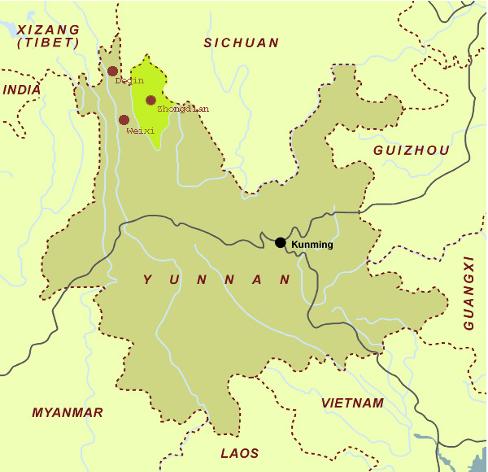
The Central Government in Beijing designated a large area of Eastern Tibet, including areas of Yunnan, Sichuan, and the eastern section of the TAR, as “Greater Shangri-la”. This area is indeed sparsely populated, and might hold some of China’s truly last frontier.
But the government has also tried to make Shangri-la into a marketing ploy by including other regions into the area that is called “Shangri-la”. While Shangri-la is officially a county in Yunnan Province, in the neighboring Sichuan Province, a small rural town also adheres to the name “Shangri-la”. But in the Sichuan case, the town called “Riwa”, located in the Yading Nature Reserve of Daocheng County, is called “Shangri-la Township”.
It is commonly misunderstood that Shangri-la County is located in the Himalaya range. Actually, the north/south range of mountains parallel to the Tibetan border are known as the Hengduan range, thus, the Himalayas are due west from Shangri-la, about 240 miles as the crow flies. But Shangri-la County has many high mountains, the highest in the county, Balagezong, sits at 5500 m. Haba Snow mountain, an easy climb for beginning mountaineers, lies at 5300 m above sea level and is in the southern area of the Tiger Leaping Gorge section of the county.
Shangri-la County has beautiful mountains, rivers, forests, and lakes to keep even the most adventurous happy. Take the Xiao Xue Shan mountain range in the northern part of the county. Snowcapped peaks, idyllic Tibetan villages, and deep river canyons are some of the areas to explore. The Tian Bao Shan, near Zhongdian, are also beautiful to traverse and explore. Qianhu, or Thousand Lakes, is only an hour’s drive from the city center. Nizu, soon to be a must visit on every traveler’s list, is a remote Tibetan valley where wildlife is abundant, and the natural beauty of waterfalls, lakes, forests, and rivers is unparalleled. Gezha Township, in Shangri-la County, also offers high lakes, and high route trekking that few get to see.
The locals say that Zhongdian ( interchanged with Shangri-la) has only two seasons—spring and winter.
Summertime temperatures are temperate, with highs around 25 degrees C (72 F ). Though this is quite comfortable for trekking and camping, nighttime temperatures can still drop to 3-10 C ( 34-50 F ). It is also advised to carry good rain gear in the summer, as Shangri-la is famous for sudden storms and heavy thunder showers. Summer temperatures are never really hot, but there is no humidity in the air, thus no mosquitoes or other annoying pests. But the weather can change very fast, and any time you are out in the mountains, you should be prepared for almost anything. When the sun shines, temperatures rise dramatically, since the high elevation sun can give you an instant burn or tan.
Winter temperatures can range from 20 C (68 F ) during the sunny day, to –15 C (6 F ) at night. Yet while the evenings are cold, when the sun shines during the day, it is possible to shed your outer clothing and get some great sun. Snowfall usually occurs in Jan. thru March, with an occasional heavy snow of 1-3 feet. Higher elevations are generally snow-free in mid-June, with the high pasture flowers in full bloom around that time. The locals, however, can remember sudden snowfalls as early as Sept. and as late as June.
September, October, and November are considered the best trekking months. The days are clear and sunny. Spring (late-April, May, and June) can also be nice, though there usually is intermittent rain showers. July and August are the rainy months, usually falling every day.
« Location of Shangri-la
